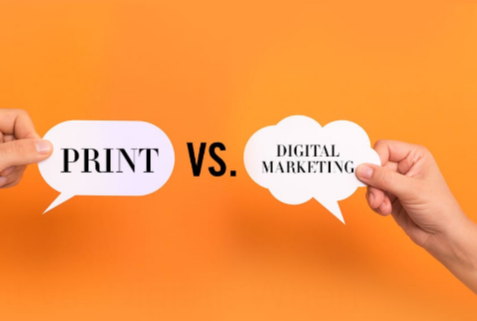Print vs. Digital: When Print Still Wins in Marketing

In today’s marketing landscape, digital channels dominate the conversation. Social media campaigns, Google Ads, and email marketing have become standard tools for reaching customers. With so much emphasis on online platforms, it’s easy to assume that print marketing is on its way out.
But the reality is more nuanced. Print hasn’t disappeared—it’s evolved. In certain situations, print still outperforms digital, offering advantages that no screen can replicate. For brands looking to cut through the noise and create deeper connections with their audiences, print remains a powerful tool.
Let’s explore when and why print still wins in marketing.
The Psychology of Tangibility
One of print’s biggest strengths is its physical presence. Unlike digital ads that disappear the moment you scroll past, printed materials demand attention by engaging multiple senses. You don’t just see a flyer or brochure—you touch it, feel its weight, and sometimes even notice the subtle scent of ink and paper.
This sensory engagement creates a stronger memory imprint. Studies show that people remember information from physical media better than from digital sources. A well-designed brochure or catalog doesn’t just communicate a message—it sticks in the customer’s mind.
For businesses that want to leave a lasting impression, especially during high-stakes campaigns like product launches or rebrands, print offers an advantage digital media can’t match.
Breaking Through Digital Fatigue
Consumers are inundated with digital messages every day. Between emails, notifications, banner ads, and social media posts, most people experience what marketers call digital fatigue. Inboxes overflow with promotional emails, and many users install ad blockers to cut down on the clutter.
This saturation makes it harder for digital campaigns to stand out. That’s where print has an edge. A well-placed poster, direct mail piece, or branded handout can surprise people precisely because it’s not digital.
Think about it: when was the last time you remembered an email ad? Now, compare that to receiving a high-quality postcard in the mail. The novelty and unexpectedness of physical marketing can make it far more memorable.
Local Reach and Targeted Campaigns
Print marketing is especially effective for businesses that thrive on local visibility. Flyers distributed in a neighborhood, menus left at a doorstep, or posters in a community center are hard to ignore. They reach people where they live and work—often more directly than a social media campaign that gets lost in a global feed.
This is where working with a local print shop becomes an advantage. A community-focused print partner understands the local market, knows what materials work best for the audience, and can deliver campaigns that resonate on the ground.
For example, a print shop in Calgary like RYNO Print & Design supports businesses with high-quality flyers, signage, and promotional items that connect directly with the local community. Whether it’s helping a restaurant distribute takeout menus or a retail store launch a seasonal promotion, local expertise makes all the difference.
Longevity and Shelf Life
Another advantage of print is its staying power. Digital ads are fleeting—they disappear the moment a user scrolls past or closes a window. In contrast, a printed item often lingers in the environment.
Consider branded calendars, notebooks, or catalogs. They sit on desks and shelves for weeks or months, keeping your brand visible long after the initial interaction. Even something as simple as a brochure can live in a drawer until the customer is ready to take action.
This extended exposure makes print cost-effective over time. Instead of relying on repeated impressions (and repeated spending) in digital campaigns, a single well-designed print piece can deliver ongoing value.
Print and Digital: Stronger Together
The best marketers don’t see print and digital as competitors—they see them as partners. An integrated approach can maximize results by combining the strengths of both mediums.
For example:
- A flyer with a QR code drives customers to a landing page.
- A direct mail postcard promotes a discount code that can be redeemed online.
- Posters at an event encourage attendees to connect on social media.
These hybrid strategies take advantage of print’s ability to grab attention while leveraging digital’s ability to track and measure engagement. In fact, research shows that response rates improve when print and digital campaigns are used together, rather than in isolation.
When Print Makes the Most Sense
Print may not be the default choice for every campaign, but there are specific scenarios where it shines:
- Launch Events – A beautifully designed invitation or program creates a sense of importance and sets the tone.
- Trade Shows and Conferences – Business cards, catalogs, and promotional materials remain essential for networking.
- High-Value Customers – Premium direct mail packages or personalized print materials show investment and attention to detail.
- Local Promotions – Door hangers, posters, and menus drive immediate community engagement.
- Brand Building – Tangible materials reinforce professionalism and permanence in ways digital ads sometimes can’t.
In these contexts, print doesn’t just supplement marketing—it can be the centerpiece of a campaign.
The Future of Print in a Digital World
Print is evolving alongside digital. New technologies, like variable data printing, allow for personalization at scale. Eco-friendly inks and recycled paper are making print more sustainable, addressing concerns about environmental impact.
Even digital-native companies are rediscovering print. Think about subscription box inserts, branded packaging, or direct mail campaigns from e-commerce brands. These are tangible experiences that strengthen customer loyalty in a way a screen never could.
Forward-thinking providers like RYNO Print & Design, a trusted print shop in Calgary, are helping businesses blend traditional print with modern marketing strategies. By offering everything from flyers to large-format signage, they ensure that companies have the tools to stand out both online and offline.
Conclusion
Digital marketing dominates the headlines, but print continues to prove its worth where it matters most: creating memorable, trusted, and lasting connections with customers.
Print isn’t an alternative to digital—it’s a complement. The most effective marketers use both, combining the immediacy of online campaigns with the impact of tangible materials.
For businesses navigating today’s noisy marketing landscape, the question isn’t whether to choose print or digital. The smarter question is: When does print give you the winning edge?




